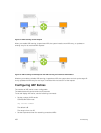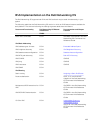
NOTE: The system provides the flexibility to add prefixes on Router Advertisements (RA) to advertise
responses to Router Solicitations (RS). By default, RA response messages are sent when an RS
message is received.
The manipulation of IPv6 stateless autoconfiguration supports the router side only. Neighbor discovery
(ND) messages are advertised so the neighbor can use this information to auto-configure its address.
However, received ND messages are not used to create an IPv6 address.
NOTE: Inconsistencies in router advertisement values between routers are logged per RFC 4861.
The values checked for consistency include:
• Cur Hop limit
• M and O flags
• Reachable time
• Retrans timer
• MTU options
• Preferred and valid lifetime values for the same prefix
Only management ports support stateless auto-configuration as a host.
The router redirect functionality in the neighbor discovery protocol (NDP) is similar to IPv4 router redirect
messages. NDP uses ICMPv6 redirect messages (Type 137) to inform nodes that a better router exists on
the link.
IPv6 Headers
The IPv6 header has a fixed length of 40 bytes. This fixed length provides 16 bytes each for source and
destination information and 8 bytes for general header information.
The IPv6 header includes the following fields:
• Version (4 bits)
• Traffic Class (8 bits)
• Flow Label (20 bits)
• Payload Length (16 bits)
• Next Header (8 bits)
• Hop Limit (8 bits)
• Source Address (128 bits)
• Destination Address (128 bits)
IPv6 provides for extension headers. Extension headers are used only if necessary. There can be no
extension headers, one extension header or more than one extension header in an IPv6 packet. Extension
headers are defined in the Next Header field of the preceding IPv6 header.
460
IPv6 Routing


















